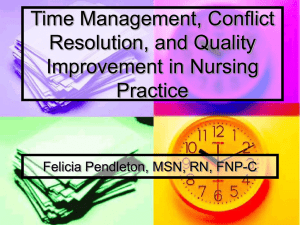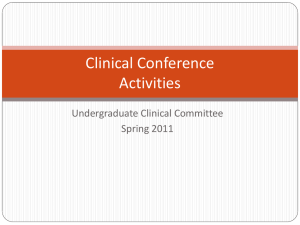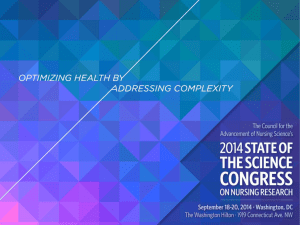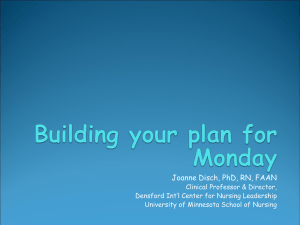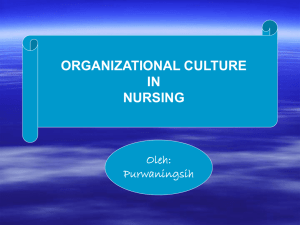Lindsay Capron MS3, UWSOM
advertisement
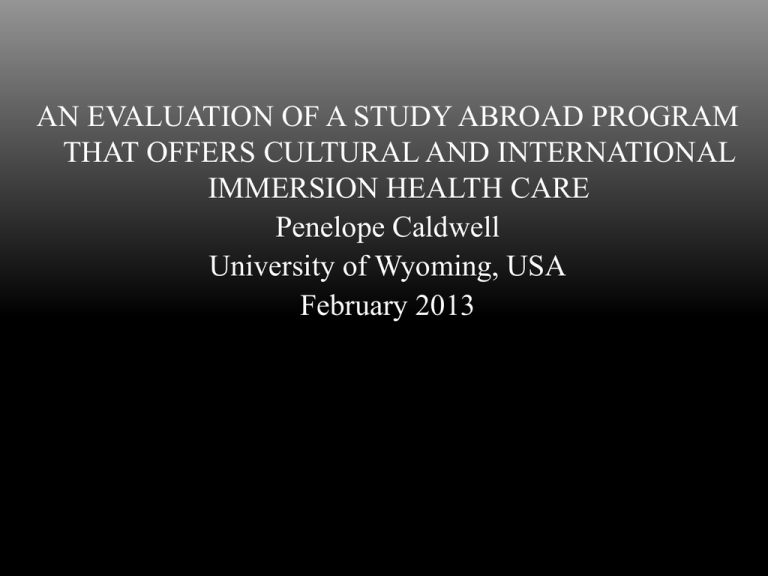
AN EVALUATION OF A STUDY ABROAD PROGRAM THAT OFFERS CULTURAL AND INTERNATIONAL IMMERSION HEALTH CARE Penelope Caldwell University of Wyoming, USA February 2013 This paper fills a gap in the literature by addresing the question: Do short-term study abroad learning services provide students with learning opportunities for long-term transformation? The Program’s Significance The underlining intention for developing this program was to increase students’ awareness of health inequities from a global perspective and increase student global competencies (ASPH, 2011) while delivering health care and health education to a village whose access to health care is minimal at best. Program significance continued.. Students who participate may enroll in a three-credit course and receive clinical practicum hours. The program offers a ten-day hands-on clinical and educational experience to students within the across campus. Interdisciplinary and inter-professional teams have taken more than 160 UW students and included 11 faculty on 12 brigades since 2007. On average the teams provide health care and education to over 500 people on each brigade. All together adding up to more than 6000 encounters in five years. Theoretical framework This paper uses transformative learning as a theoretical framework developed by Jack Mezirow (2000) and further developed by Patricia Cranton (2006). Mezirow (2000) defines transformational learning as, The process by which we transform our taken-for-granted frames of reference (meaning perspectives, habits of mind, mind-sets) to make more inclusive, discriminating, open, emotionally capable of change, and reflective so that they may generate beliefs and opinions that will prove more true or justified to guide action. (p. 8) Cranton (2006) elaborates on Mezirow’s theory by describing the process of transformational learning as: a) awakening or sensitizing students to issues of social justice and impressing upon them their role in making a difference; b) engaging students with innovative, action-based, powerful learning modes that develop critical, creative, and constructive skills; and c) reflection to make meaning of the learning experience and to revise and replace unhelpful habits of mind. Literature Review A review of the literature revealed two approaches that increase the quality of learning outcomes from study abroad programs. One approach is to prepare students ahead of time by providing them with concepts of global health care and inequalities prior to immersion The literature encourages institutions to offer courses to help prepare students before immersions. Reflection is cited frequently as the most common teaching modality. (Abrams & Maltby, 2009; Carpenter & Garcia, 2012; Edmonds, 2012; Evanson & Zust, 2006; Levine, 2009; Kirkham, et al., 2009; Larson & Reif, 2010; Levi, 2009; Levine, 2009; McAllister, 2005). The other approach speaks to the importance of creating partnerships and long-term commitments with the host community, explicitly avoiding invading a vulnerable community and causing more harm than good (Bond, et al., 2012; Flint, et al., 2010; Leffers, et al., 2010; Levi, 2009; Fitzgerald & Wasunna, 2005). Project Design The methodologies this evaluation study uses are descriptive and qualitative interviewing and written statements with participants who have previously participated on one or more of the immersion trips at least a year or more prior to the interview. This evaluation reports on results from eight student responses, which strongly suggest emerging themes are congruent with criteria (Mezirow, 2000; Cranton, 2006) for long-term transformational learning. Sample and interview tool The inclusion criteria for choosing participants is that they must have participated on at least one trip to Honduras, and that their trip took place at least one year prior to the interview. The recruitment question is, “May I interview you about your immersion experience in Honduras?” Limitations in this program evaluation are, this author knows most of the students being interviewed. The interviewer will address this limitation by having each participant review the reported response to assure it is consistent with the interviewee’s perceptions (member check) immediately after each interview; A second limitation is the small sample. Further interviews are planned and the evaluation process will continue until saturation is apparent. TRANSFORMATIONAL CHANGE DISCUSSION: Awakening students to issues of social justice and making a difference. (first criteria) ‘Alex’, an engineering student, who went to Honduras to assess the water conditions in the village, wrote, “My experience in Honduras brought me to pursue a different direction ... it made me start asking myself how I could make a difference ... (the trip) presented me with the task of figuring out what it was that I was good at and how I could better apply it in a way that it would do the most good to as many as I could around me. After much profound thought, I decided that I wanted to, rather than be an engineer, dedicate myself to helping those Hispanic people that have a difficult time because of a lack of education, resources, or sometimes a lack of legal documents. I decided that the way to best do this would be with a law degree.” Responses that pointed to developing critical, creative, and constructive skills (second criteria). ‘Bea’ was a nursing student at the time of her trip. Bea develops an holistic perspective from her immersion experience. She writes: “My experience in Honduras … helped shape me to be the nurse I am today. It taught me to take care of my patients as a whole, keeping in mind their physical, emotional, spiritual and cultural needs. Everyone is unique they may have the same diagnosis but they don’t have the same needs. It is my passion to take care of my patients as a whole and treat them all as individuals. It took this trip for me to realice the impact and importance of this.” ‘Cathy’ is a medical student who became acutely aware of the lack of access to health care while in Honduras. Cathy writes: “I have been struck by the suffering of people without access to care. In Honduras, I met a woman who ground up acetaminophen to press into a large, gaping wound in her ankle, her home remedy searing her open flesh. I hope to one day provide a community with access to regular medical attention, not only curing sickness but also promoting good health.” ‘Deena’ was a nursing student at the time of her immersion in Honduras. She also had an appreciation for access to preventitive care, she writes: “Being in Honduras opened my eyes, made me truely appreciate the importance of preventitive care. It also raised my awareness of access issues to healthcare not only globally but locally. I'm excited to work with people who struggle to get quality preventitive healthcare.” Students reflected on the ‘meaning’ of their experience in Honduras and showed signs of revising habits of mind (third criteria). ‘Heather’, a family nurse practitioner student, wrote: “I learned that despite the cultural differences, people are people, and despite the lack of ability to communicate verbally you are still able to see that their ultimate goal is to care for their families. Daily I work with patients who have very little English speaking skills. I think my service trip helped me learn to have patience to figure out a way to communicate with these patients. What it boils down to is they are just like me, or just like the people that we served in Honduras, they are looking for a better way of life or a way to better care for a loved one.” Felicia’, a nursing student during her immersion writes, “I learned that being a good nurse is so much more than having good technical skills, it requires a passion and a love for people.” Students reflected on the ‘meaning’ of their experience continued….(third criteria). ‘Gina’, now a nurse practitioner, writes: “The way I perceive the world and myself within it has changed. I was humbled when I came to the stark realization that I needed the people of Agua Salada much more than they needed me.” ‘Edith’, a nursing student, was inspired by working within an interdisciplinary team. She writes: “I was transformed by the holistic nursing that was practiced and inspired by the cultural reverence within our team of students, nurses, and doctors. The experience I had in Honduras through the University of Wyoming was more beneficial to my education and career than any time spent within the walls of a classroom. It was truly life changing.” Conclusion In conclusion, though the sample is small, this initial response from eight participants strongly reflects Mezirow (2000) and Cranton’s (2006) transformational learning critieria. These eight students found new ways to see the world they live in and new ways to act within their scopes of practice. They became deeply self-reflective, leading to new discoveries about who they are and how they can make a difference in their communities. One participant, Alex, saw his new role in the larger global picture and made significant change in order to ‘make a difference’ globally. This program’s approach, which aligns with literature recommendations, which are preparing students prior to emerging, and creating mutual trust with host communities, may prove to be crucial elements that laythe foundation for longterm transformational learning. This evaluation will continue interviewing participants of the program until saturation is clearly evident. The results will help show whether this small sample of eight responses is only a cluster, or if this sample represent the program’s ability to successfully achieve long-term transformational learning by offering short-term study abroad learnign services. Thank-you References Abrams, S., & Maltby, H. J. (2009). Seeing with new eyes: The meaning of an immersion experience in Bangladesh for undergraduate senior nursing student. The Berkeley Electronic Press, 6(1). Retrieved from: http://www.bepress.com/ijnes/vol6/iss1/art33 Ailinger, R. L. & Kollar, S. J. (2002). International clinical experience: Long-term impact on students. Nurse Educator, 27, 28-31. Amazigo, U., Okeibunor, J., Matovu, V., Zoure, H., Bump, J., & Seketeli, A. (2007). Performance of predictors: Evaluating sustainability in community-directed treatment projects of the African programme for onchocerciasis control. Social Science and Medicine, 64(10), 20702082. Association of Schools of Public Health (ASPH) (2011). Global Health Competency Model. Retrieved from: http://www.asph.org/document.cfm?page=1084 Bond, M. L., Gray, J., Lail-Davis, V. J. Opollo, J. G. (2012). Meeting tomorrow’s health care needs through local and global involvement. The Journal of Continuing Education in Nursing, 43(2), 7580. Carpenter, L., & Garica, A. A. (2012). Assessing outcomes of a study abroad course for nursing students. Nursing Education Research, 33(2), 85-89. Cranton, P. (2006). Understanding and Promoting Transformative Learning. John Wiley & Son, JosseyBass, San Francisco, CA. DeDee, L. S., & Stewart S. (2003). The effects of student participation in international study. Journal of Professional Nursing, 19, 237-242. Doolittle, l., Gregory, D. M., Harrowing, J. N., Lee, B., O’Sullivan, P. S., (2012). A critical analysis of undergraduates students’ cultural immersion experiences. International Nursing Review. References continue ... Edmonds, E. (2012). An integrative literature review of study abroad programs for nursing students. Nursing Education Review, 33(1), 30-34. Evanson, T. A., & Zust, B. L. (2006). ‘‘Bittersweet knowledge’’: The long-term effects of an international experience. Journal of Nursing Education, 45(10), 412–419. Ferketich, S., Jennings, B. M., Mitchell, P. H. (1998). Quality Health Outcomes Model. Journal of Nursing Scholarship, 30(1), 43-46. Fitzgerald, D.W., Wasunna, A. (2005). Away from exploitation and towards engagement: An ethical compass for medical researchers working in resource-poor countries. The Journal of Law, Medicine & Ethics, 33(3), 559-567. Flint, E. P., Gilliss, C. L., Hewitt, H. H., Powell, D. L. (2010). Application of a partnership model for transformative and sustainable international development. Public Health Nursing, 27(1), 54-70. Hall, V., Hart, A., Henwood, F. (2002). Helping health and social care professionals to develop an ‘inequalities imagination’: a model for use in education and practice. Journal of Advanced Nursing, 45(5), 480-489. Hsieh, H., & Shannon, S. E (2005). Three approaches to qualitative content analysis. Qualitative Health Research, Retrieved from: http://qhr.sagepub.com/content/15/9/1277. Hudzik, J. K. (2011). Comprehensive Internationalization: From Concept to Action. NAFSA: Association of International Educators, Washington D.C. Jewell, L. M., Proctor, P., and Racine, L. (2012). Putting the world as classroom: An application of the inequalities imagination model in nursing and health education. Journal of Transcultural Nursing, 23(1), 90-99. References continued... Kirkham, S. R., Pankratz, D., Van Hofwegen, L. (2009). Keeping the vision: Sustaining social consciousness with nursing students following international learning experiences. International Journal of Nursing Education Scholarship, 6(1). DOI: 10.2202/1548-923X.1635 Knight, J. (2001). Monitoring the quality and progress of internationalization. Journal of Studies in International Education, 5(3), 228-243. Leffers, J., Mitchell, E. (2010). Conceptual model for partnership and sustainability in global health. Public Health Nursing, 28(1), 91-102. Levi, A. (2009.) The Ethics of Nursing Student International Clinical Experience. JOGNN, 38(1), 94-99. Levine, M. (2009). Transforming Experiences: Nursing Education and International Immersion Programs. Journal of Professional Nursing, 25(3), 156-169. Fitzgerald, D.W., Wasunna, A. (2005). Away from Exploitation and Towards Engagement: An Ethical Compass for Medical Researchers Working in Resource-Poor Countries. The Journal of Law, Medicine & Ethics, 33(3), 559-567. Green, M. F. (2012). Global Citizenship: What Are We Talking About and Why Does It Matter? Trends & Insights For International Education Leaders. Retrieved from: http://www.nafsa.org/ McAllister, M. (2012). STAR: A Transformative Learning Framework for Nurse Educators. Journal of Transformative Education, 9(1), 42-58. Mezirow, J. (2000). Learning As Transformation-Critical Perspectives on a Theory in Progress. John Wiley &Son, Jossey-Bass, San Francisco, CA. Millennium Development Goals, (MDGs) (2012). Retrieved online: http://www.undp.org/ content/undp/en/home/mdgoverview/mdg_goals/mdg8/ Nash, D. B., Reifsnyder, J. A., Fabius, R. J. & Pracilio, V. P. (2011). Population Health: Creating a Culture of Wellness. Jones & Bartlett Learning: Sudbury, MA. Nursing Study Abroad (2012). GoAbroad.com. Retrieved from: www.studyabroaddirectory.com/ listings.cfm/degprogID/75



